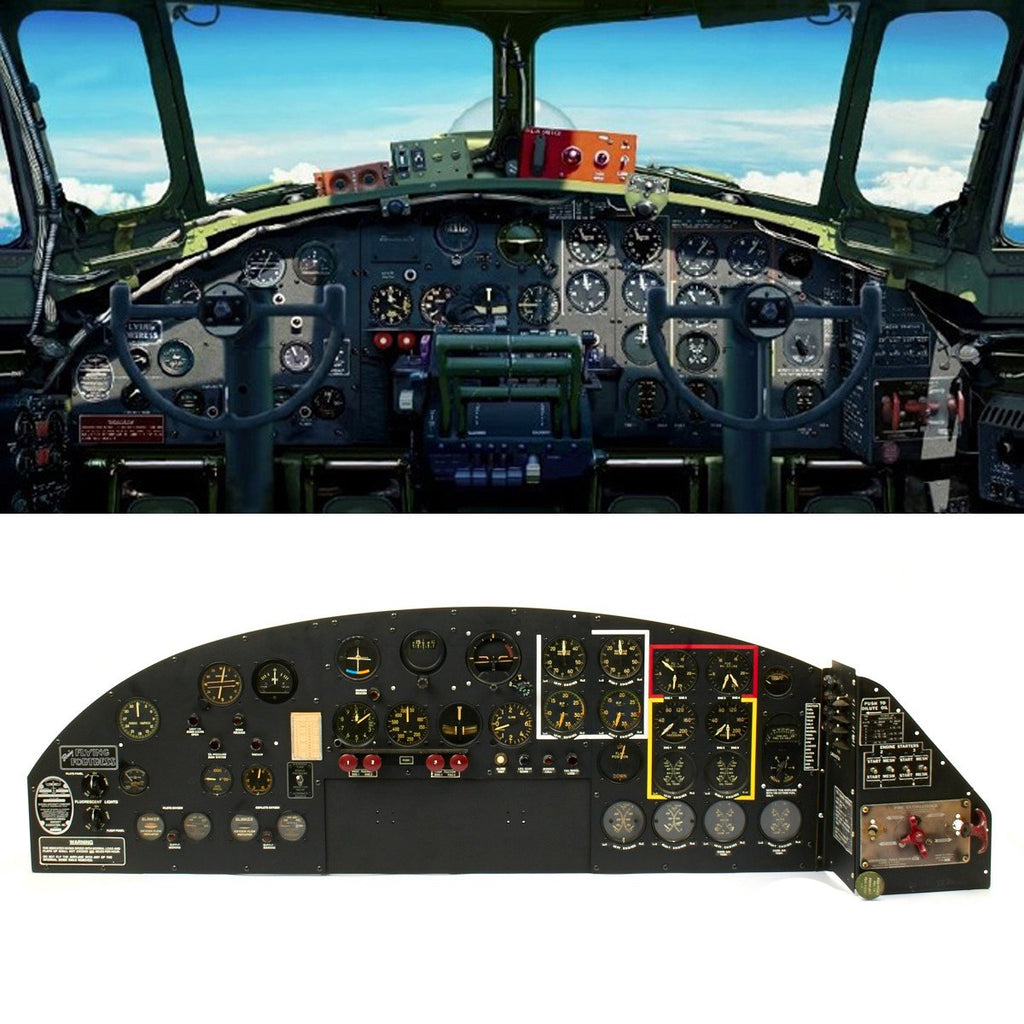Item Description
Original Item: Only One Available. The frame of this panel is newly constructed of plywood but the vast majority of the instruments are original WW2 production! We believe this panel was made by a collector about 10-15 years ago, research reveals a website in which he wrote the following:
I had an interest in heavy bombers all my life and a while back, I had the chance to purchase a lot of original Boeing drawings of the B-17 instrument panel. I started by building a prototype panel in luan mahogany plywood. In a few months I had found most of the instruments I would need on ebay. Originality was what I really wanted and the original B-17's had a 3 piece phenolic panel screwed onto a plywood frame. To my knowledge, no one has successfully been able to build these frames, due to a lack of fully dimensioned drawings. I had half size drawings of all the wooden parts of this frame and some finished dimensions on other drawings. I put the two together and had the critical length dimension of the finished panel. Using a very high end large scanner and e sized printer, I was able to increase the size with the scanner until I had the length correct. I then created full sized paper templates from the scans. From these paper templates I created a set of full sized masonite templates. I will use these to cut and form up all the plywood sections of the main wood panel frame. I am a R&D machinery design engineer and in my daily job. I use some pretty sophisticated 3d cad and scanning/printing equipment. The ability to redraw the original Boeing panel plans into 3d, gave me a way of building 3D models of all the parts, including the gauges and putting them all together in a "Virtual panel.
The material is ¼ fir plywood, just as it was during WWII when Boeing built them. The front, back and bottom have 1/16 deep slots routed into them at the precise locations of the four vertical ribs. First the bottom and back panel are glued and clamped together. Tightbond woodworking glue is used on all joints. They remain clamped for 24 hours then the front panel is added. On day three the ribs are fitted and everything is squared up and clamped as seen here. Only the small left end, which wasn’t added till the next day.
There has been tremendous attention to the detail in the original Boeing drawings of these parts. Slots and holes for cables and hoses are in the precise locations stipulated in the drawings. Now that all the instruments are in place it’s time to add the final touches to the panel. This includes the "Flying fortress" plate and the Boeing serial # plate. Also the compass calibration card holder is added to the left hand panel.
The panel measures approximately 64 W x 18 H x 16 D.
On July 28, 1935, a four-engine plane took off from Boeing Field in south Seattle on its first flight. Rolling out of the Boeing hangar, it was simply known as the Model 299. Seattle Times reporter Richard Smith dubbed the new plane, with its many machine-gun mounts, the Flying Fortress, a name that Boeing quickly adopted and trademarked. The U.S. Army Air Corps designated the plane as the B-17.
In response to the Army’s request for a large, multiengine bomber, the prototype, financed entirely by Boeing, went from design board to flight test in less than 12 months.
The B-17 was a low-wing monoplane that combined aerodynamic features of the XB-15 giant bomber, still in the design stage, and the Model 247 transport. The B-17 was the first Boeing military aircraft with a flight deck instead of an open cockpit and was armed with bombs and five .30-caliber machine guns mounted in clear blisters.
The first B-17s saw combat in 1941, when the British Royal Air Force took delivery of several B-17s for high-altitude missions. As World War II intensified, the bombers needed additional armament and armor.
The B-17E, the first mass-produced model Flying Fortress, carried nine machine guns and a 4,000-pound bomb load. It was several tons heavier than the prototypes and bristled with armament. It was the first Boeing airplane with the distinctive and enormous tail for improved control and stability during high-altitude bombing. Each version was more heavily armed.
In the Pacific, the planes earned a deadly reputation with the Japanese, who dubbed them four-engine fighters. The Fortresses were also legendary for their ability to stay in the air after taking brutal poundings.
Seventy-five years after the B-17’s first flight, an 88 year-old veteran sent The Boeing Company a letter. After explaining how he returned to England after a bombing raid over Germany with 179 flak holes and only two out of the four engines, he wrote: I’m glad to be alive. Thank you for making such a good airplane.
Gen. Carl Spaatz, the American air commander in Europe, said, Without the B-17 we may have lost the war.
- This product is not available for international shipping.
- Eligible for all payments - Visa, Mastercard, Discover, AMEX, Paypal & Sezzle





































